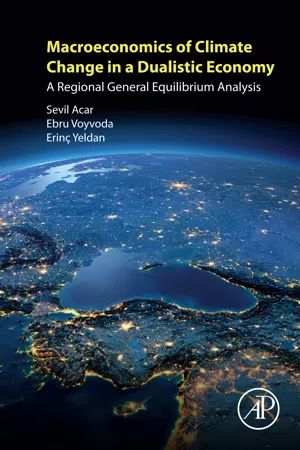Macroeconomics of Climate Change in a Dualistic Economy intends to construct a series of regional and dynamic general equilibrium models that accommodate the structure and dynamics of the dual trap embedded in the Turkish economy. These models include the analysis of macroeconomic development policies that are designed at the regional level, as well as those that are aimed at climate change abatement and mitigation. Recent studies have focused on environmental issues and have taken the macroeconomic structure of the modeled economies as given. We are of the opinion that by incorporating underlying characteristics of a dual economic structure, alongside questions of sustainability, increasing greenhouse gas (GHG) emissions, and income distribution, Macroeconomics of Climate Change in a Dualistic Economy can address questions, such as:
• What effects do energy and environmental policies in Turkey have on national and regional GHG emissions?
• What effects may “greening” policies of the Turkish economy have on regional employment and development patterns?
• How will patterns of production and employment be shaped in strategic sectors of the Turkish economy (i.e., agriculture, automotive, construction, machine industry, and advanced services) by “greening” and regional development?
• From the viewpoint of social welfare:What is the optimal mix of taxation, subsidization, and technology policies in the Turkish economy that will alleviate the duality trap, sustain “greening” efforts, and mitigate climate change?
The key contribution of Macroeconomics of Climate Change in a Dualistic Economy rests on addressing the issues of duality and environmental policy on climate change within a general equilibrium modeling approach. We therefore hope that the modeling will be of interest to students studying the macroeconomics of development, general equilibrium modeling, and the economics of climate change. The last topical area focuses on a burgeoning field surrounding policy debates on the 2°C target set by the UN and the participants of the widely-acclaimed COP meetings. Coupled with a discussion of recent advances in dynamic multiregional applied general equilibrium modeling, the proposed methodology is expected to be of wide interest to graduate students, applied researchers, practitioners, and researchers from both the academic and public sectors.
1.1. Background
Various aspects of sustained growth (or lack of) under regional fragmentation and patterns of duality have long been reported in the literature, especially regarding the structuralist tradition (Ros, 2000; Taylor, 1983; 2004). “Dual” economic structures have recently come to the forefront of the development economics literature, with seminal contributions from Fields (2004), Laitner (2000), and Temple (2005). In his survey of the concept for growth economists, Temple (2005) noted that “dual economy models (ought to) deserve a central place in the analysis of growth in developing countries (…) with factor misallocation, aggregate growth in the presence of factor market distortions, international differences in sectoral productivity, and the potential role of increasing returns to scale.” Our investigation will go beyond the analyses of “traditional” dualism (based on differences in the wage rate from labor’s marginal product in traditional agriculture) to encompass what Bertrand and Squire (1980) noted as “modern-sector dualism,” with an advanced modern sector generating and sustaining traditional-sector conditions with a poverty trap based on informality and fragmentation.
Classic treatment of “Duality” was introduced to the literature with the dual-economy models of Fei and Ranis (1964) and Lewis (1954). Both visions highlighted the pathways of transitional growth via the transference of unlimited supplies of labor from traditional agriculture to modern industry. In their view, duality initially was referred as a diverse structure, which nevertheless followed a smooth adjustment toward modernity. As labor was lured from low-productivity (actually zero) traditional agriculture to high-productivity urban industries, growth occurred through lifting the masses toward a modern society.
However, over 50 years of research has clearly revealed that one of the striking feature of the mode of development is polarization of income per capita, which occurs across global, national, and regional economies. The expected smooth transition that destroys (creatively, according to Schumpeter? We doubt it!) traditionally stagnant rural economies, and moves masses out of poverty into the modern urban centers of growth, has not taken place. Globalization in the 20th century created miracles and disasters thus filling the ranks of what Colander termed as the bottom 1 billion, where daily per capita incomes fell below one dollar. Rates of growth were, on average, negative over the last quarter.
Such polarization was not limited across nations. Informalization, fragmentation, and social exclusion are indispensable outcomes of modern enclaves; in short, modern and formal centers of growth have simultaneously created and sustained fragmented informal bases. In Turkey, modern Istanbul not only retains and produces backwardness in Urfa, but also generates further Urfas within its geographical domain. As informal Urfas surround the Istanbul core, fragmented and dualistic activities form the basis of cheap labor sources and consist mainly of socially-excluded migrants who are, in turn, pressed to offer their labor power in “a race to the bottom.” Turkey’s experience is by no means unique. It is part of a larger picture of the international division of labor within the global economy, where formal and informal structures exist side by side as part of a larger social formation. In their study of the structural transformation of India’s economy, Rada et al. (2012) noted that “a widening gap between India’s skilled and well-...
